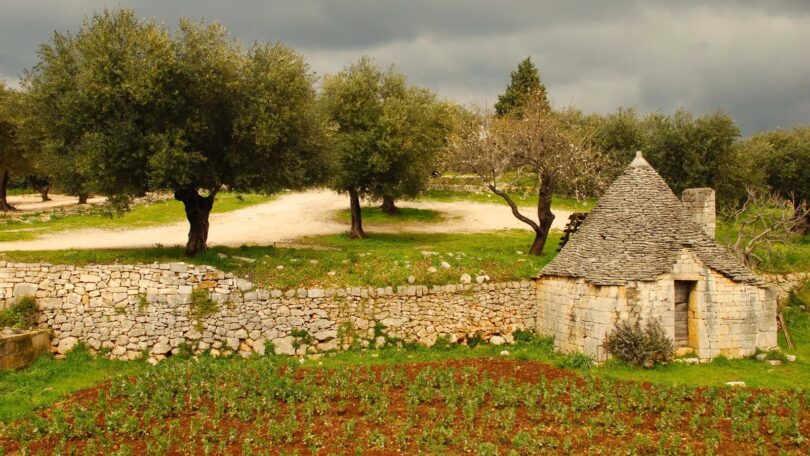Victoria Abbott Riccardi
Fifty-six kilometres south of the Puglian port city of Bari, on the heel of Italy’s boot, I could see several small stone huts with conical rock-covered roofs scattered among the olive trees on both sides of the road. Reminiscent of teepees or tiny forts, these structures were unlike anything I’d ever encountered.
While Puglia is famed for its buttery green olive oil, fruity red wines and orecchiette pasta with broccoli rabe, it’s also known for these ancient architectural wonders called trulli (singular, trullo). Found throughout the Itria Valley – where there are approximately 50,000 in total – trulli are particularly abundant in the town of Alberobello, where roughly 1,500 of them pack the districts of Rione Monti and Rione Aja Piccola. Some trulli stand alone, while others are clustered together along the town’s cobbled lanes transformed into residences, shops, restaurants and even boutique hotels. Today, the trulli of Alberobello are a Unesco World Heritage site, although many people outside Italy have never heard of these conical structures.
“Trulli are products of the Messapian culture and are present in the regions of Puglia that have known that cultural influence,” said Annunziata Berrino, author of a book on the trulli of Alberobello and a professor of contemporary history at the University of Naples Federico II.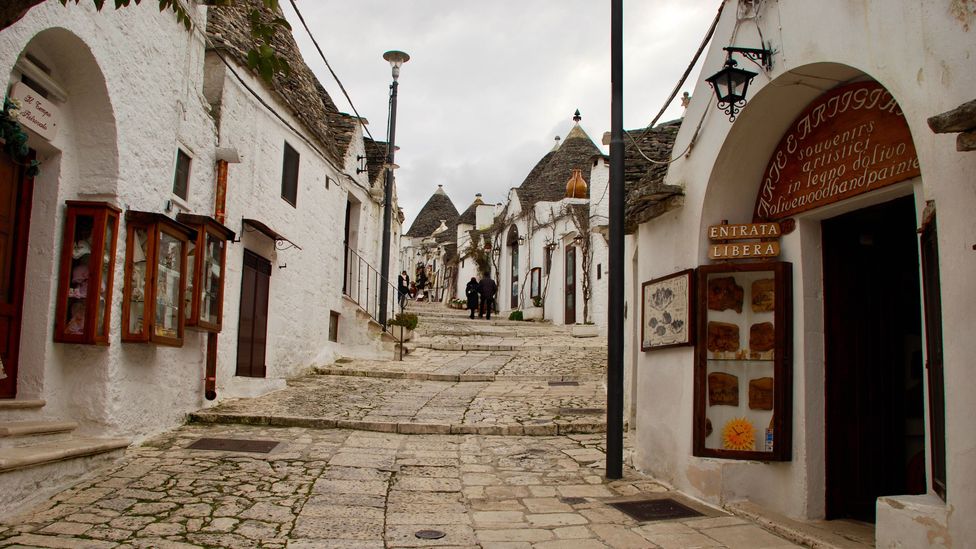
The cobbled walkways in Alberobello are lined with trulli, including this one selling paintings on local olive wood (Credit: Victoria Abbott Riccardi)
The Messapians belonged to a group of tribes called Italics and settled in the region that is now Puglia during the Iron Age (1200-550 BCE). Although there is no clear consensus on when the first trulli were built, most sources agree the oldest are several thousand years old.
Their name’s origin also remains uncertain, although some have speculated that the word trullo comes from turris or trulla, the Latin word for dome. Others suggest trullo comes from thòlos, the Greek term for tomb.
According to Berrino, Puglian trulli initially were built to serve as temporary field shelters for shepherds and animals, especially during the heat of the summer, and were constructed from stones that locals removed from the rocky soil to plant olives trees and grape vines. Over time, these huts began to function as storage spaces for farm equipment as well as permanent homes for farmers and small-scale landowners.
“What we call trulli today were called casedde, small houses built for residential use or stables,” Berrino explained. “Other stone buildings in Puglia have somewhat different shapes and other names, including specchie, mussels and truddi. During the early 20th Century, when the fame of Alberobello began to spread in Italian culture, the term ‘trullo’ was then affirmed, which began to define all the Apulian buildings with the typical conical stone roof.”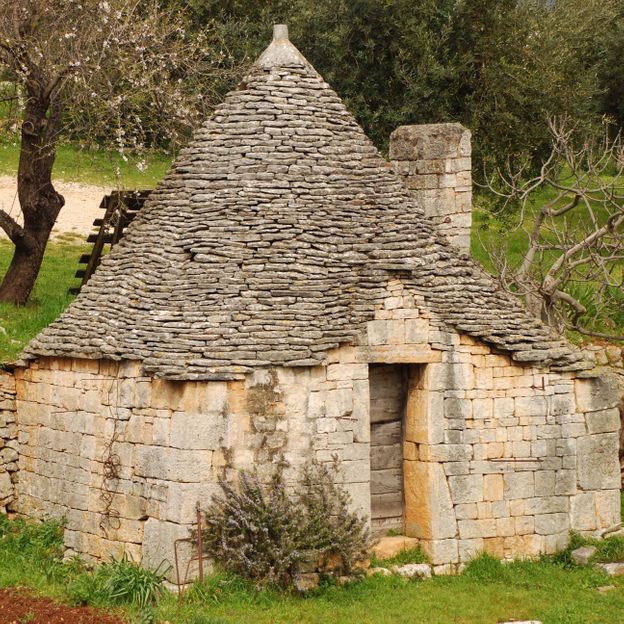
Trulli were initially built as temporary shelters for shepherds and animals (Credit: Victoria Abbott Riccardi)
What’s remarkable about the trulli of Alberobello is how well they’ve stood the test of time despite being built using drywall (mortarless) construction. This prehistoric building technique, which is still in use to restore trulli today, does not use a sandy material (such as cement or plaster) mixed with water to form a paste to “glue” the stones together. Instead, the builder relies on his ability to assemble the stones in such a way as to form a stable structure.
A trullaro, or master trullo builder, would oversee the engineering and building of these shelters, which began with the fabrication of a subfloor cistern from boulders collected in nearby fields. Then, using local limestone excavated on site, along with soil and water, the trullaro built the base with double-leaf walls (where an airspace is between the internal and external walls) that allowed the structure to stay cool in the warmer months and insulate it in winter. Over time, the inner and outer walls were whitewashed with lime to prevent insect infestation.
To support the conical roof, the trullaro first placed four main blocks on the top corners of the base. Then, he would construct the three-part dome, comprised of an inner layer made from wedge-shaped supporting stones (the candela), followed by insulating filler and an external layer of corbelled limestone slabs (the chiancarelle) to facilitate water drainage. A decorative pinnacle, said to ward off evil or bad luck, topped each dome.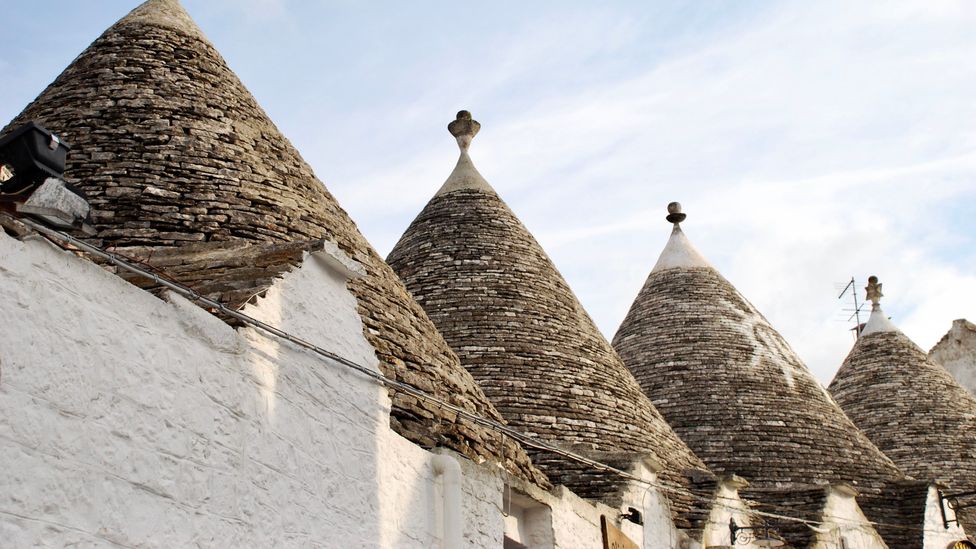
The decorative pinnacles on the top of trulli were said to ward off evil or bad luck (Credit: Victoria Abbott Riccardi)
“Trulli have a strong symbolic value in our area,” explained Chicca Maralfa, an independent journalist and press office director of Bari Chamber of Commerce. “They represent the peasants of Apulia, who [were] working people, proud of their commitment to the land and economic independence.”
Trulli have a strong symbolic value in our area. They represent the peasants of Apulia, who [were] working people, proud of their commitment to the land and economic independence
Legend has it that the mortarless construction of these huts also served a clever purpose. According to the Municipality of Alberobello, Ferdinand l, ruler of the Kingdom of Naples (1458-1494), gave the Acquaviva family a forested fiefdom – eventually called Alberobello – perhaps as a reward for fighting in the Crusades. The family let small groups settle there to till the land in exchange for certain privileges. However, since feudal lords had to pay taxes on settlements, the Acquaviva family ordered the labourers to build their shelters (trulli) with no mortar. That way, the peasants could knock down their dwellings before the king’s tax collectors arrived and quickly rebuild them after they left.
Over time, this trulli settlement expanded, and, by the end of the mid-16th Century, approximately 40 trulli dotted the area that forms today’s districts of Rione Monti and Rione Aja Piccola. The settlement continued to flourish over the centuries, and the expanding population continued to build these regional-style dwellings.
While most trulli were single-storey structures, the building that houses the Trullo Sovrano museum in Alberobello is a rare example of a trullo with an elevated floor reached by a masonry staircase. The museum’s left wing represents the original building that dates to the early 1600s. The addition was built in the mid-1700s for a priest, who housed his employees in surrounding trulli.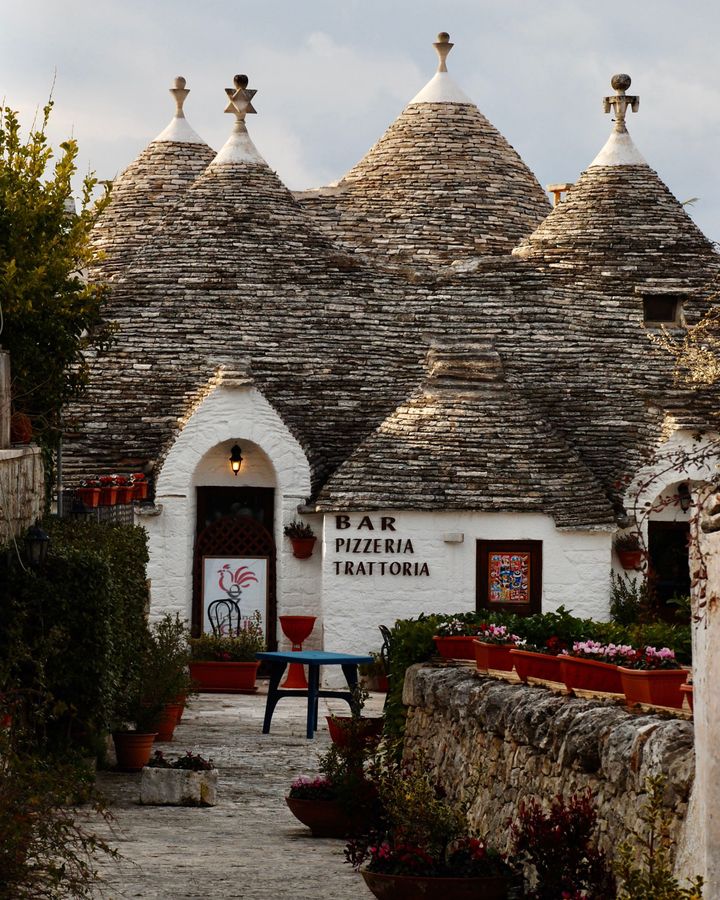
Many of Alberobello’s trulli have been transformed into residences, shops, hotels and restaurants (Credit: Victoria Abbott Riccardi)
As I strolled up Via Monte Pertica, not far from the museum, I noticed that most of the trulli had arched doorways, including a shop selling traditional linen goods and another decorated with ancient farm tools peddling locally made crafts. Continuing up the cobbled walkway toward the 20th-Century church, Chiesa di Sant’Antonio, I also observed that some trulli had white symbols on their conical roofs. According to Unesco, these white ash markings have mythological or religious significance.
Because the trulli of Alberobello are considered unique and vital to the region’s cultural legacy, Italy has been protecting them since 1909, when the country designated them heritage monuments. Today, it’s illegal to demolish, reconstruct or add floors to a trullo, as well as build an imitation one. Moreover, local legislations prescribe how a trullo can be maintained and restored by a trullaro.
Case in point, chef-owner Domenico Laera had to hire a trullaro before he opened Ristorante L’Aratro in Alberobello in 1987. “My restaurant is located in several trulli rooms,” said Laera, who was born and lives in Alberobello. “I [built] the kitchen in one of the interior rooms with a lot of difficulty because the rooms are very small. I modified the terrace to create a welcoming environment. The floors are original, and the bathrooms were made with [local] limestone.”
The first reaction [is] amazement for the environment and [then] they begin to fantasise about what it could be like to live in a trullo
The 150-sq-m space holds up to 90 diners who feast on regional specialties such as locally made burrata with ham and pureed broad beans with wild chicory within the original exposed stone walls, archways and domed ceilings. When asked how visitors respond to dining in a trullo, Laera said, “The first reaction [is] amazement for the environment and [then] they begin to fantasise about what it could be like to live in a trullo.”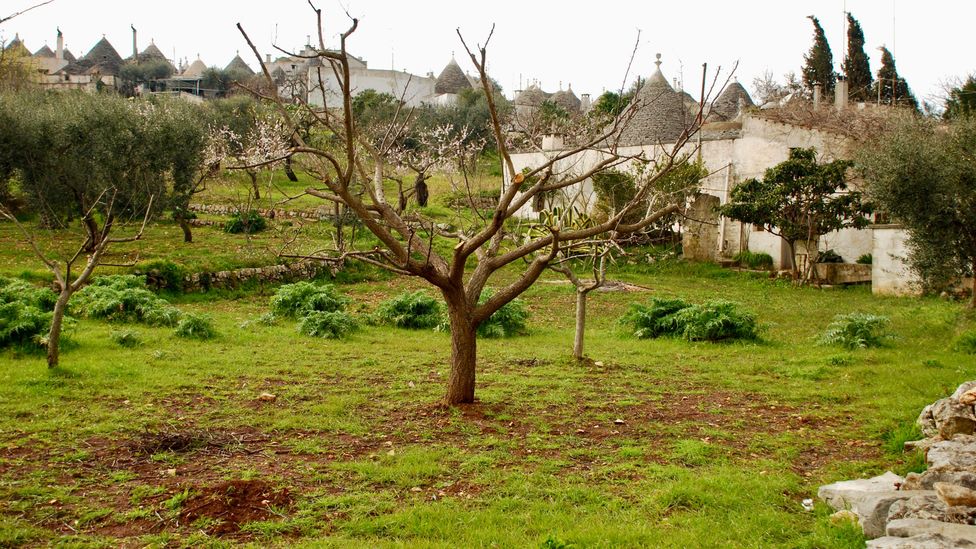
There are approximately 50,000 trulli scattered throughout Puglia’s Itria Valley (Credit: Victoria Abbott Riccardi)
Thanks to various outfitters, such as Airbnb, visitors to Puglia can spend the night in a trullo. Additionally, Alberobello native Alessandro Paiano has several renovated trullo that guests can rent through his company Charming Trulli. Most of Paiano’s trulli are in Alberobello, including two that he restored to their original splendour, typical of the sorts of trulli built in the 18th Century (albeit with modern bathrooms, WiFi, heating and air conditioning and a minibar). “One [trullo] is dedicated to the basket maker and the other to the shoemaker, he said, adding that each one contains its respective original tools.
No surprise, Paiano lives in a trullo in Alberobello. “It is a restored project of three trulli and a new part,” he said. “[I have] a garden, swimming pool, fully equipped kitchen and living area with a fireplace.”
Berrino also owns a restored trullo in Alberobello, which she uses as a secondary residence. “My trullo was originally composed of a single large trullo and two alcoves on the sides on the ancient road from Alberobello to Martina Franca,” she said. “In 2006, I restored the entire building and, in particular, all the stone parts and outdoor spaces, which are very important for the trulli because they represent the [structure’s] relationship with nature.”
Although Maralfa does not live in a trullo, she has spent many a night in one. “Sleeping in a trullo is a journey through time,” said the journalist, who wrote a best-selling novel in 2018 featuring trulli. “I find them magical places – a unique experience for anyone who wants to understand the true soul of this region.”
She added: “To me, [trulli] are the maternal womb of Puglia. One feels embraced inside a trullo. It’s a different kind of sleep, a pampering for the spirit. [You have] the smell of the stone, the climate is right, the light never intrusive and time and space merge into a more human, welcoming dimension. Saving the trulli and the landscape in which they are immersed means saving ourselves, our history and the culture to which we are heirs.”
Courtesy: bbc

